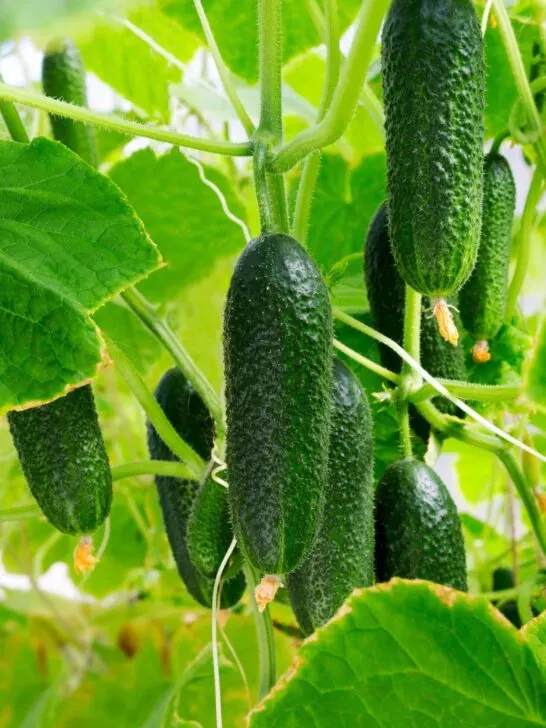Rhubarb is a cold hardy, herbaceous perennial vegetable whose root system survives for many years while the above-ground portion dies back each winter and grows anew each spring.
This tart vegetable is most commonly eaten like fruit, in crisps, muffins, simple syrups, and other sweet dishes. I love to use my steam juicer to make rhubarb juice!

As an Amazon Associate I earn from qualifying purchases.
Jump to:
What is companion planting?
Companion gardening is the practice of planting two or more plants together for the benefit of one or both plants. By planting rhubarb with certain plants, you can help increase the growth and vigor of your rhubarb while reducing the likelihood of pests and diseases on both the rhubarb and the companion plant (s).
It's like a food forest, but on a smaller scale!
What are the benefits?
There are many reasons why companion planting is beneficial, but some of the benefits specific to rhubarb include:
- help to protect from pests and diseases.
- improve growth and vigor, and in some cases, even flavor!
- help to attract beneficial insects, which will then prey on pests.
- improve soil health, through nitrogen fixation and nutrient cycling
- provide optimal growing conditions, such as shade or ground cover.

Considerations:
- will the plants shade each other and compete for sunlight?
- will the plants attract or deter pests?
- will they compete for the same space?
- will they compete for the same nutrients in the soil?
- will the companion plants interact badly with each other?

The best companion plants for rhubarb
Here are some of my picks for companion planting rhubarb, in alphabetical order:
Alliums:
The allium family includes garlic, onions, and chives. These delicious and fragrant plants are excellent choices for planting with rhubarb. Their intoxicating scent helps to deter pests like aphids, whitefly, and weevils, and may even help to deter slugs. As an added bonus, alliums help to deter big pests too, like rodents and deer from eating your rhubarb plants.
Don't forget about the ornamental alliums! Many ornamental alliums also deter pests. Do consider avoiding alliums if you're planting beans!

Brassicas:
The brassica family includes cauliflower, broccoli, cabbage, and kale, among others! This companion planting pair is a bit more one-sided, as the brassicas use the rhubarb more than the rhubarb uses them!
The large, broad leaves of the rhubarb plant are excellent at offering shade and protection from the sun, preventing sun damage to the cole crops, like brussels sprouts, all the while deterring common pests like whitefly.

Legumes:
Rhubarb's relationship with beans and peas is actually beneficial to both plants. The high levels of oxalic acid in rhubarb leaves helps to deter aphids from the beans while the bean and pea plants capture atmospheric nitrogen and convert it to a stable, usable source of nitrogen for the growing rhubarb to improve growth and yield!
Avoid planting beans or peas near alliums, as they are not great garden friends.

Strawberries:
Strawberries are an excellent companion plant for rhubarb. This is one of those "if they taste good together, they grow good together" pairs. Their fruit tends to ripen around the same time as rhubarb so they can be harvested and eaten together.
Strawberries are also herbaceous perennials, but they occupy a different space than rhubarb. Strawberries are a great edible ground cover crop, which is an incredibly important part of the equation. Their short, broad stature and penchant for sending out stolons effectively cover the ground, maintaining moisture, preventing excessive soil drying and erosion, and also suppressing weeds.

Plants to avoid planting near rhubarb:
While there are many plants that enjoy life near rhubarb, there are also a few plants that should be avoided in the vegetable garden.
Melons:
Yes. Juicy, sweet melons! Watermelons, cantaloupes, and other melons require a lot of direct sunlight to produce their delicious bounty, and the plant knows how to get it. If the melon plant feels that it's not getting enough sunlight, it will react phototropically, which means it will grow towards the light, vining up, and growing over anything in its way, even your rhubarb!

Pumpkins:
We've all had a pumpkin plant or two get out of control, so you know what they are capable of! Pumpkins are related to melons and are also big into getting enough sun, and they'll do it by any means possible, including suffocating your rhubarb.

Sunflowers:
Sunflowers are great arugula companion plants, BUT they're terrible for rhubarb! Sunflowers are susceptible to the same weevil, rhubarb curculio, and planting these two in close vicinity is just ringing the dinner bell for these pests! Try to plant your sunflowers in another part of the garden!

Can't Get Enough Companion Planting?
Final thoughts
While rhubarb itself is a very hardy plant, companion planting can really help to improve the other plant's growth, yield, and pest resistance. By pairing rhubarb with plants that have complementary characteristics, like alliums for their scent or beans for their nitrogen fixation ability, gardeners can create a thriving ecosystem in their garden. Just be sure to avoid planting sunflowers or melons near your rhubarb, as they will only cause problems!
Don't be afraid to try new plant combinations, either! But don't forget to think about the space, sunlight, nutrient, and pest angles.
Pin This Rhubarb Companion Planting Guide!





